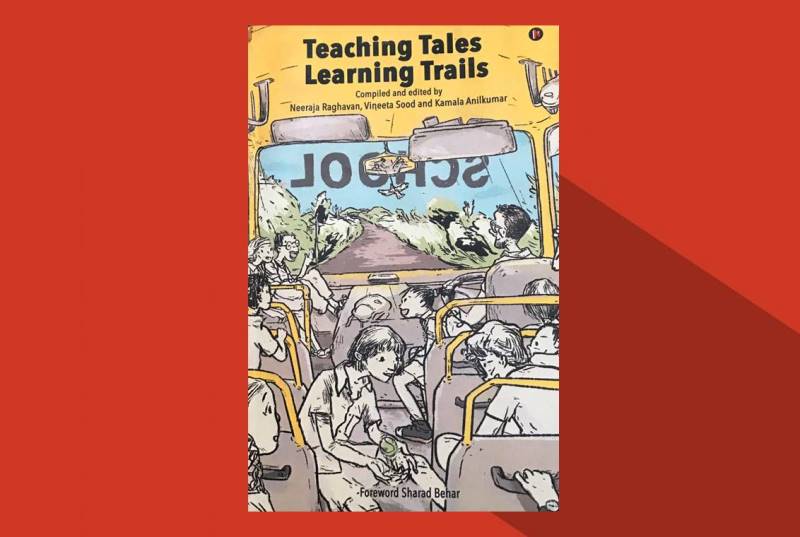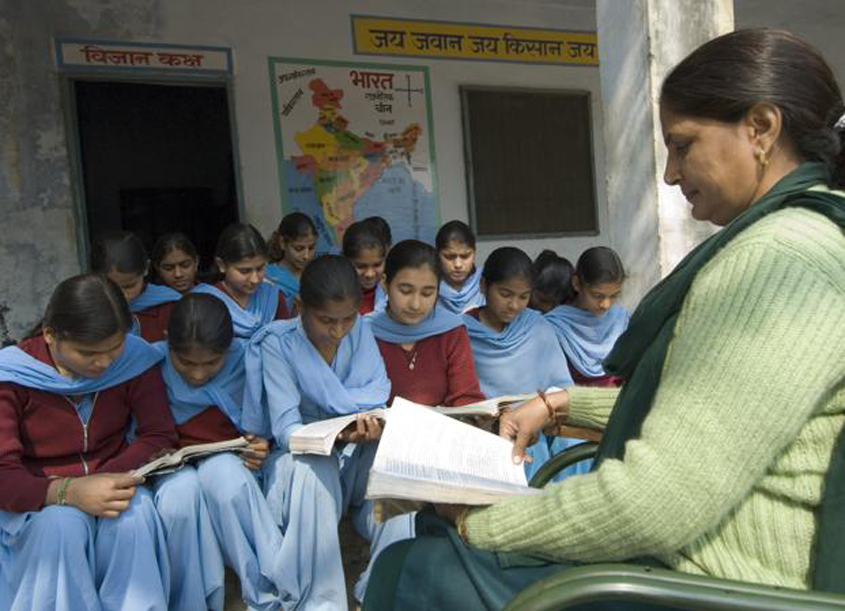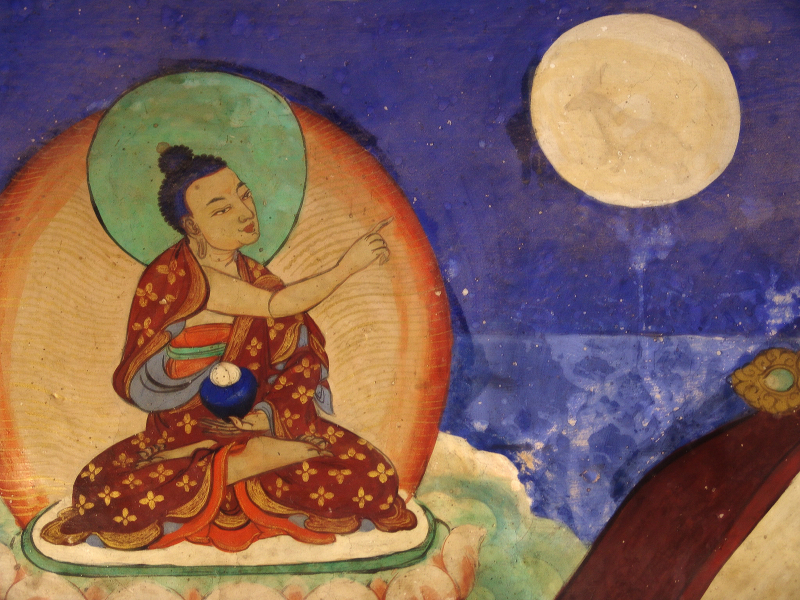BOOK REVIEW
Teaching Tales Learning Trails takes you on a journey of self-discovery through the hustle-bustle in the classroom to the dilemmas in the teacher’s mind. The stories in the book are sure to encourage a thought provoking debate on the altering contours of education and the practice of teaching-learning in our classrooms.
Priyanka Yadav | The New Leam

Teaching Tales and Learning Trails is a book written by Neeraja Raghavan, Vineeta Sood, and Kamala Anilkumar in which the authors have put together stories and their experiences with the institution of education.
Each story that the book contains is woven together in a manner that evokes and stimulates critical thinking among the readers, and further compels the reader to understand more empathetically the genesis of the problems that learners and teachers face in the entire teaching-learning process.
Overall the book is an enjoyable read which makes the reader travel through the lived experiences of the writer and engage with him/her more closely in order to understand the problems which he/she faces while learning or teaching.
The education system in India broadly follows a standardized method of teaching and a largely uniform curriculum but despite the apparent homogeneity, it is marked by its distinctive subjectivities that lend to it a character that is distinctive and rich.
Every individual has a different experience within the same education system and therefore it is not wrong to say that the educational realm is shaped by individual experiences, unique stories and narratives that uphold a refreshing picture.
Every person owns a story woven through their experiences, and this is what the authors Neeraja Raghavan, Vineeta Sood and Kamala Anil Kumar have tried to compile in their book Teaching Tales, Learning Trails.
Why do they have to be something else?
Let them all just be them,
You be you and me be me.
The book has one story each based on individual experiences of a learner/child, a teacher and a parent because the authors felt the need to experiment in the domain of education. They assert that just like the way it is practised in management courses where crafting and discussing of authentic case studies is a time-tested means of developing managers, so they felt that since many elements in the stories emerged from true-life experiences, any reader who reads the stories would immediately find a connection with the stories, which might have been played out in their lives as well.
We often tend to blame the education system of the country for the lapses in the social, cultural, political and economic domains. It is central to our thinking that education shapes us and enables us to discover our inner potential. It can also be argued that it is education that is understood as a mould that shapes people, determines their thinking and behavioural practices.
Thus education is seen to be integral to human development and to the development of the society as well. While the education system is blamed all the time, it is true that critiquing it in isolation cannot be justified as it faces several structural constraints.
The structure has genuine problems but what cannot be denied is the fact that despite the innumerable structural constraints, the onus of rebuilding and empowering the education system lies to a great extent on its key participants- the teachers and the learners. However it cannot always be mended through policies and changes in the school curriculum, one cannot have a narrow compartmentalised approach in order to enhance the process of learning.
Thus subjectivity takes precedence and this is what the authors have tried to do in the book by providing a plethora of stories based on subjective experience which can act as case studies that evoke a thought process among the readers.
It is through these stories that the reader is invited to see where the problem lies and understand who needs to be blamed and for what. Learning does not only involve the teaching that goes on in the school as an institution but is a larger interplay of interactions between several players like the teachers, the parents, the peers and the society.
It is a combined interplay of these factors that shape the personality of the learner and constitute the nuanced experience of education.
The authors through the medium of stories have tried to point out towards the root cause of the problems which a learner/child faces and how these simultaneously shape the mind of the child. This book is divided into two sections, section one is entitled Teaching Tales and section two is entitled Learning Trails.
Section one is a compilation of the stories based on subjective experience and section two is more of a discussion on the stories which is moderated by the authors and discussed with parents, teachers, students, principals, teachers trainers and teachers educators individually.
The discussion is centred on the stories and individual opinion is sought on the same, a solution or a suggestion is finally made by collectively looking at each of the opinions provided by the discussants and by the moderator.
This book has tapped into ideas like the differential learning capacity of every child through stories like ‘Success or Failure?’ and ‘Out of the Box’, where the traditional or conventional method of teaching is challenged to understand that the same is not restricted to books and classrooms only, it actually transcends beyond the boundary of the classroom and is based on the empathetic relation between the teacher and the student and the pace at which a student learns.
In the story ‘Success or Failure?’, the writer cautions “Each at their own frequency, right?” reminding us of the importance of allowing each learner the opportunity to learn at their own comfortable pace.
In the story “Out of the box”, the teacher after realising the pace and the way a child Aarav learnt remarked
It wasn’t that Aarav was not learning, it was rather that he did not respond in the way I expected, he actually understood everything but his only difficulty was the expected mode of communication, and the moment I took him out of the box everything changed.
Not every time can one expect a teacher to be empathetic or expect that the teacher engages with the student personally, this can be a personal disposition of the teacher, but the structural impediments and the administrative responsibilities with which the teacher is burdened apart from teaching does not provide them enough scope to reflect on their own actions or the reactions of the student. Therefore what otherwise is known to be a creative exercise becomes mechanical where everybody is just concerned about completing their working hours and not concerned about anything beyond that.
The theme is very well captured in the story ‘Teacher Chatter’, where the teachers are made to realise that they are not just meant to perform a job but rather perform a task of responsibility which involves creativity and personal willingness which will come if they act from a space of giving rather than being trapped with negative feelings like being paid inadequately, being burdened by work, being given little respect socially.
The authors argue that the negative feelings that teachers have about their profession and the absence of positive social feedback disables teachers from making efforts in the classroom.
Teaching as a profession is looked down upon in the society; it is often gendered and considered as the last resort in any individual’s career choice.
This is paradoxical because teaching requires adequate skills, patience, perseverance, empathy and an attitude of giving, and using several faculties in order to facilitate learning of the child and further make the entire process meaningful.
Any profession requires creativity and individual involvement and passion to gain maximum productivity, it is important for an individual to realise what his or her potentials are before blaming a profession for its reputation.
Any task performed with lack of interest will have negative results and thus it will adversely impact the reputation of the job.
Reena Kumar taps her passion for teaching, as she narrates in her story ‘The Fire’– in the anecdote she shares how she established a pre-school at her residential space and how she could manage to foster children from all sections of the society.
Reena Kumar says “I ran my pre-school for twelve years, and worked at a residential school for thirteen, always with the youngest group. The fire always kept burning and my purpose in life became to look after children”.
As learners, children often in their early age struggle to find out who they are, what their interests are and what is it that they are passionate about.
The process of knowing what one is good at or what is it that interests one may not always be supported by the pressures asserted by the education system in particular and the larger social milieu in general. The system is often not conducive to the learner’s inclinations and may make it impossible for them to find out their interests, poor academic performance and stress are all its outcomes.
This aspect of the teaching process and learning capacities is quite beautifully woven in the story ‘Who Am I ? ’.
The story talks about a student named Tina who is helped by a life coach, on the request of her parents, to understand what her true potential is, which was not academics but arts. In a conversation between the life coach Neera and Tina it becomes apparent that as a mentor Neera touches the deepest corner of Tina’s soul and becomes a companion in her journey toward self-discovery.
Not every learning activity is guided towards individual learning and finding our highest potential, sometimes it is marked by building reputation in the society and amongst the peers, which in a way leads to an environment of constant pressure to perform and be the best always. This pressure is well narrated by Neeraja Raghavan and Vineeta Sood in the section on ‘Testing Times’ that is quite brilliantly put together.
Teachers need educators too, either professionals or in the form of superiors or peers, in order to enhance their teaching capacity and sometimes also to look at their mistakes or the areas where they lack, ‘Teacher Chatter’ and ‘The Stuff of Staff Meetings’ are the two stories from the compilation which introduce the readers to this aspect of teachers learning.
The authors have brilliantly compiled the stories to raise and make the readers aware about several intricate issues which affect the teaching-learning process. The stories are like individual case studies which equip the reader to make an interpretation of their own and further evoke their critical sensibilities towards finding solutions to the problems in the education system.
Overall the book is a brilliant and thought provoking compilation of stories which hits the reader’s mind and compels him/her to get back to their own childhood memories in order to relate with each story.
The narration and the style of writing are quite engaging and empathetic, where one can do nothing but believe in the narratives put forth, the choice of stories have been quite intelligent as each story interestingly points out towards the problem or issue the writer has faced.
The second half of the book is quite mindfully designed in order to accommodate the opinions of different sets of people with regard to the stories, although it tends to get a little lengthy at some points.
All the arguments put forth by the authors are well articulated.
This book is a brilliant and thought provoking read for anybody who wants to engage with the problems one faces in a teaching-learning system.
As these stories are like case studies it can be helpful for any person who wishes to enhance the teaching-learning process by knowing its limitations through the medium of these critical stories.













